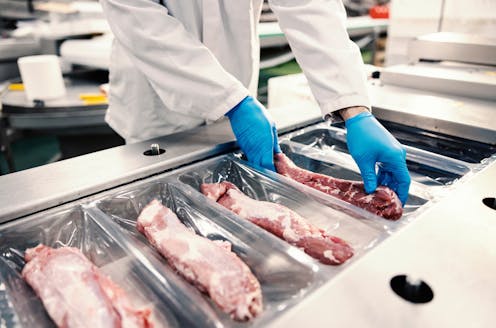
A United Nations special rapporteur recently released a damning report describing Canada’s Temporary Foreign Worker program as a “breeding ground for contemporary forms of slavery.” The report detailed the many ways migrant workers have been mistreated in Canada, including excessive work hours, limited breaks and physical abuse.
The report’s revelations have intensified scrutiny of the broader reliance on temporary foreign workers in Canada. The structural dependency on such workers spans various sectors of the Canadian economy and has become a pointed site of critique.
In response to the UN report, the Trudeau government announced on Aug. 26 that it plans to dramatically reduce the size and scope of the Temporary Foreign Worker program. Several industries, however, will be exempt from changes to the program, including food processing.
Read more: Canada needs to overhaul the Temporary Foreign Worker program, not just tinker with it
Research we have conducted since 2020 on Canada’s beef processing sector has uncovered the industry’s predatory reliance on low-wage immigrant and temporary migrant workers. The strategic selection of workers who are new to Canada and heavily dependent on their employers is a tactic that we call intentional precarity.
This tactic exploits the vulnerable position of these workers, allowing employers to maintain a workforce that is less likely to demand better conditions or fair wages.
Low wages
The beef processing industry is characterized by low wages and work that is dirty, difficult and dangerous. While business lobbies and firms argue they can’t find enough workers, the real issue is that few are willing to endure such intensely hard work for such low wages.
The industry relies on the Canadian government to supply these low-wage workers through programs like the Temporary Foreign Worker program, which advocates have long critiqued and which economists argue suppresses wages.
A meatcutter at JBS in Brooks, Alta., for example, starts at $21.85 an hour, which works out to about $41,000 a year. This is below Alberta’s median hourly wage of $28.85.
To put this into perspective, renting an apartment in Brooks or High River, Alta. is comparable to Calgary. In addition, workers usually must own a vehicle and car insurance to commute to work due to a lack of public transportation infrastructure.
Wages in this industry have not always been so low. Prior to 1984, meatpacking paid eight to 12 per cent above the average manufacturing wage. This meatpacking wage then plummeted to just 82 per cent of the industry average from the mid-1980s to 1997. The industry further consolidated, and firms moved out of Alberta’s big cities and into more rural areas, out of sight.
High profits
Meanwhile, meat processing firms have been yielding incredible profits. Beef production is highly profitable for the transnational corporations that dominate the industry.
In Alberta, 70 per cent of all the beef in Canada is slaughtered at two foreign-owned firms: the U.S.-owned Cargill plant in High River and the Brazilian-owned JBS Canada plant in Brooks, Alta. Running 24 hours a day and seven days a week, these plants slaughter between 4,000 and 4,500 cattle per day and employ between 2,000 and 2,800 workers each.
Both Cargill and JBS are ranked on Forbes Global 2000 list, which ranks the largest companies in the world based on sales, profits, assets and markets. In 2023, JBS posted profits of US$3 billion while Cargill, the largest privately held company in the U.S., saw its revenues decline from US$177 billion in 2023 to US$160 billion in 2024.
In 2021, the year following the deaths of three people in connection with the COVID-19 outbreak at its High River plant, Cargill posted record profits of US$5 billion.
Exploitation of temporary workers
According to the 2021 Census, the Alberta meatpacking industry relies heavily on immigrants. Seventy-two per cent of workers in the Alberta meatpacking sector are immigrants, including a significant number of resettled refugees (19 per cent). An additional 10 to 30 per cent of the workforce are temporary foreign workers.
This trend can be traced back to the early 2000s, when Lakeside Packers started recruiting resettled refugees as workers after being unable to fill positions with local workers. When Lakeside Packers in Brooks (now JBS Foods) expanded in the 1990s, they sought to fill positions at the plant with Canadian workers from Atlantic Canada and British Columbia. However, word of the poor working conditions quickly discouraged potential employees.
Between 2000 and 2005, approximately 2,000 former refugees from Sudan and Somalia resettled in Brooks to work at Lakeside. Then, in 2005, Lakeside workers went on strike to obtain a union contract.
Following the strike, Lakeside’s labour recruitment strategy shifted toward hiring workers through Canada’s Temporary Foreign Worker program. Specifically, the industry stated it was interested in hiring workers “accustomed to physical labor.” Temporary foreign workers are viewed as a preferred labour pool by employers because they are tied through their work permit to their employer and less likely to assert rights to workplace safety.
A dangerous trend for all
The fundamental issue in southern Alberta’s meatpacking sector is not a shortage of labour, but rather insufficient wages. The industry is dominated by large, foreign-owned firms that constantly push for greater profits at the expense of employees, perpetuating a cycle of under-payment and poor working conditions.
The government’s facilitation of long-term very low-wage jobs performed by temporary foreign workers is deleterious for all workers in the sector.
As the beef industry continues to extract record-breaking profits, it’s clear that the terms of employment have to change. The current model is unsustainable and demands urgent review and adjustments to create a fairer and more just labour market.
Bronwyn Bragg receives funding from the Social Sciences and Humanities Research Council of Canada.
M Jennifer Hyndman also receives funding from the Social Sciences and Humanities Research Council of Canada.
This article was originally published on The Conversation. Read the original article.





!["[T]he First and Fifth Amendments Require ICE to Provide Information About the Whereabouts of a Detained Person"](https://images.inkl.com/s3/publisher/cover/212/reason-cover.png?w=600)

